The Bulldozer Review: AMD FX-8150 Tested
by Anand Lal Shimpi on October 12, 2011 1:27 AM ESTGaming Performance
AMD clearly states in its reviewer's guide that CPU bound gaming performance isn't going to be a strong point of the FX architecture, likely due to its poor single threaded performance. However it is useful to look at both CPU and GPU bound scenarios to paint an accurate picture of how well a CPU handles game workloads, as well as what sort of performance you can expect in present day titles.
Civilization V
Civ V's lateGameView benchmark presents us with two separate scores: average frame rate for the entire test as well as a no-render score that only looks at CPU performance.
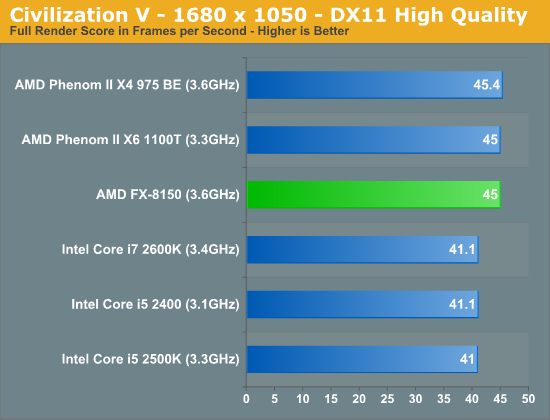
While we're GPU bound in the full render score, AMD's platform appears to have a bit of an advantage here. We've seen this in the past where one platform will hold an advantage over another in a GPU bound scenario and it's always tough to explain. Within each family however there is no advantage to a faster CPU, everything is just GPU bound.
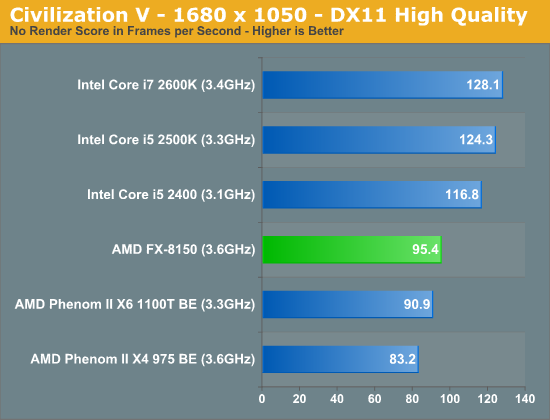
Looking at the no render score, the CPU standings are pretty much as we'd expect. The FX-8150 is thankfully a bit faster than its predecessors, but it still falls behind Sandy Bridge.
Crysis: Warhead
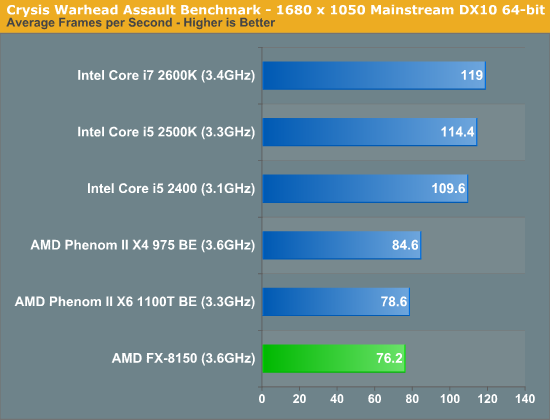
In CPU bound environments in Crysis Warhead, the FX-8150 is actually slower than the old Phenom II. Sandy Bridge continues to be far ahead.
Dawn of War II
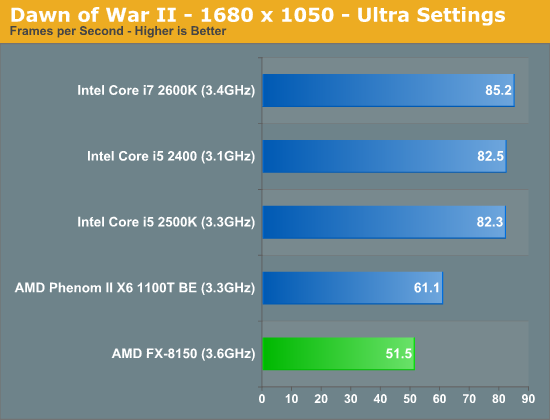
We see similar results under Dawn of War II. Lightly threaded performance is simply not a strength of AMD's FX series, and as a result even the old Phenom II X6 pulls ahead.
DiRT 3
We ran two DiRT 3 benchmarks to get an idea for CPU bound and GPU bound performance. First the CPU bound settings:
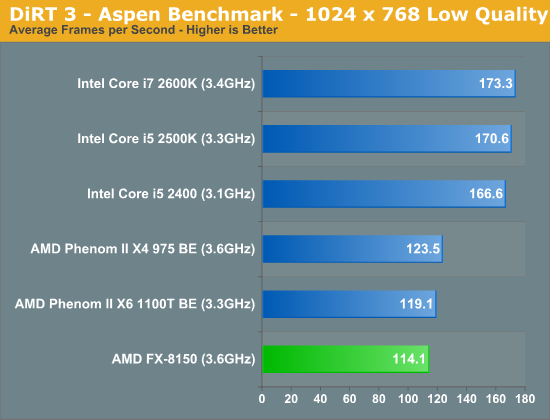
The FX-8150 doesn't do so well here, again falling behind the Phenom IIs. Under more real world GPU bound settings however, Bulldozer looks just fine:
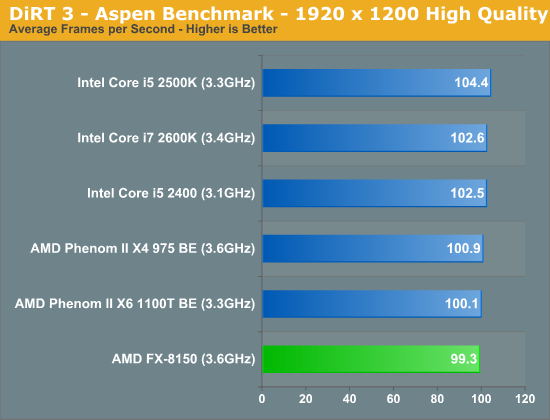
Dragon Age
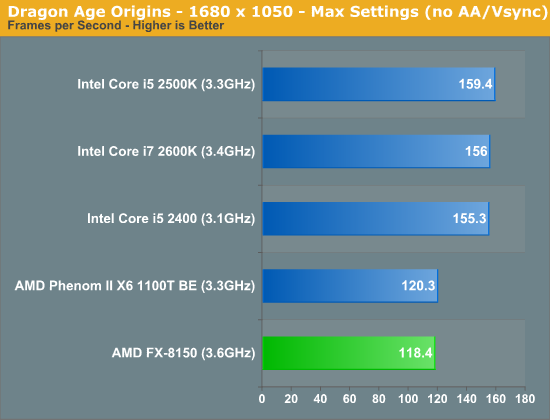
Dragon Age is another CPU bound title, here the FX-8150 falls behind once again.
Metro 2033
Metro 2033 is pretty rough even at lower resolutions, but with more of a GPU bottleneck the FX-8150 equals the performance of the 2500K:
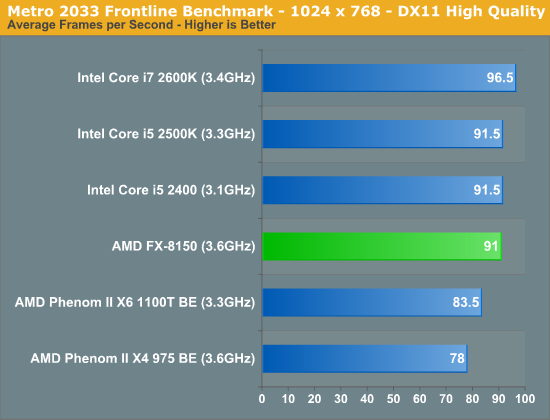
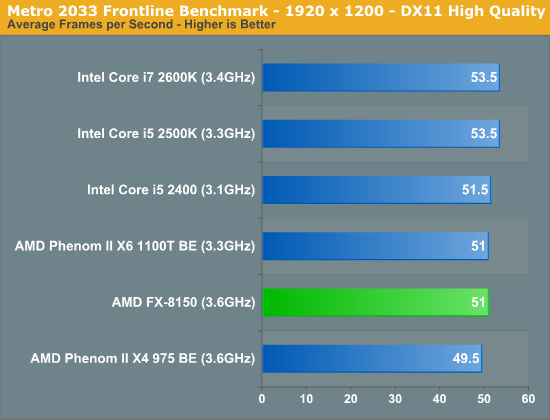
Rage vt_benchmark
While id's long awaited Rage title doesn't exactly have the best benchmarking abilities, there is one unique aspect of the game that we can test: Megatexture. Megatexture works by dynamically taking texture data from disk and constructing texture tiles for the engine to use, a major component for allowing id's developers to uniquely texture the game world. However because of the heavy use of unique textures (id says the original game assets are over 1TB), id needed to get creative on compressing the game's textures to make them fit within the roughly 20GB the game was allotted.
The result is that Rage doesn't store textures in a GPU-usable format such as DXTC/S3TC, instead storing them in an even more compressed format (JPEG XR) as S3TC maxes out at a 6:1 compression ratio. As a consequence whenever you load a texture, Rage needs to transcode the texture from its storage codec to S3TC on the fly. This is a constant process throughout the entire game and this transcoding is a significant burden on the CPU.
The Benchmark: vt_benchmark flushes the transcoded texture cache and then times how long it takes to transcode all the textures needed for the current scene, from 1 thread to X threads. Thus when you run vt_benchmark 8, for example, it will benchmark from 1 to 8 threads (the default appears to depend on the CPU you have). Since transcoding is done by the CPU this is a pure CPU benchmark. I present the best case transcode time at the maximum number of concurrent threads each CPU can handle:
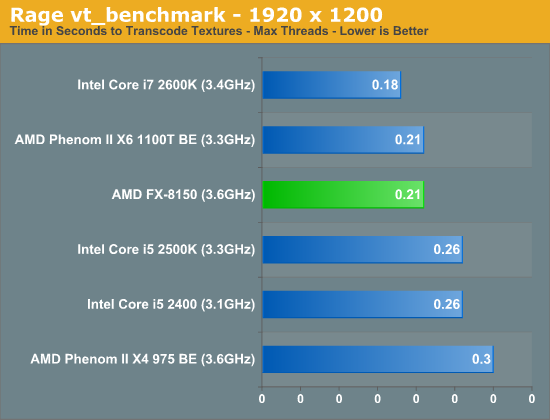
The FX-8150 does very well here, but so does the Phenom II X6 1100T. Both are faster than Intel's 2500K, but not quite as good as the 2600K. If you want to see how performance scales with thread count, check out the chart below:
Starcraft 2

Starcraft 2 has traditionally done very well on Intel architectures and Bulldozer is no exception to that rule.
World of Warcraft
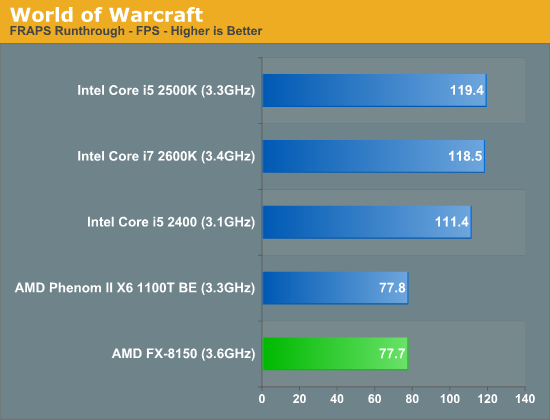


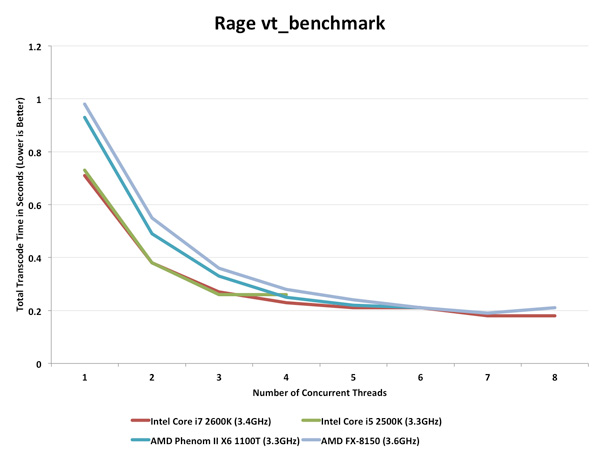








430 Comments
View All Comments
medi01 - Thursday, October 13, 2011 - link
Slightest "problem" imaginable with AMD GPUs would make it into titles.nVidia article would go with comparing cherry picked overclocked board vs standard from AMD, with laughable "explanations" of "oh nVidia marketing asked us to do it, we kinda refused but then we thought that since we've already kinda refused, we might still do what they've asked".
"Objectively", are you kidding me?
JKflipflop98 - Thursday, October 13, 2011 - link
Anand runs the test, then writes down the number. Then he runs the test on the other PC, and writes down the number.If your number is lower, then it's physics "badmouthing" your precious, and not the site.
actionjksn - Wednesday, October 12, 2011 - link
@medi01 Considering the results I think Anand were more than kind enough to AMD.medi01 - Thursday, October 13, 2011 - link
I recall low power AMD CPUs being tested on 1000Watt PSUs on this very site. How normal was that, cough? iPhones "forgoten in pocket" (authors comment) on comparison photos where they would look unfavourably)Thing with tests is, you have games that favour one manufacturer, then other games that favour another. Choose "right" set of games, and viola...
The move with 1000Watt PSU on 35W TDP CPU is TOO DAMN LOW and should never happen.
On top of it, absolute majority of games is more GPU sensitive, than CPU sensitive. Now one could reduce resolution to ridiculously low levels so that CPU becomes a bottleneck. but then, who on earth would care whether you get 150 or 194 frames per second at a resolution which you'll never use?
Stas - Thursday, October 13, 2011 - link
Not sure what the deal is with PSUs or what article you're referring to. I'm assuming it made AMD power consumption look worse than it was because 1kW PSU was running at 10% load, thus way out of efficiency range. But w/e. My comment is mostly on CPU performance in games. Just because you don't run a game on the top-end CPU with $800 in multi-gpu tandem at lowest settings, doesn't mean it shouldn't be used to determine CPU performance. By making the CPU the bottleneck, you make it do as much as it can side-by-side with the GPU spiting out frames while whistling tunes and picking it's finger nails. There is more load on CPU than GPU. Which ever CPU is faster - that CPU will provide more FPS. Simple as that.Sure, no one will see 20%-30% performance difference using more appropriate resolution and quality settings. But we're enthusiasts, we want to see peak performance difference and extreme loads. Most synthetic tests are irrelevant in everyday use, but performance has been measured that way for decades.
jleach1 - Friday, October 14, 2011 - link
I haven't seen one single sentence that was questionable in a and graphics review. In fact I'm glad to say that I'm a big fan of Intel CPU and and hour combos, and have never had even as much as a hint of bias.As a over exaggeration, in an age where were all stuffing multiple cards in our systems, and cards are efficient, reliable, powerful, and they run cool. yes the drivers have sucked in the past, but they don't really.
(emphasis on the word seem)
NvIdia cards have just seemed clunky and hot as hell since the 400 series. I don't feel like gaming next to a space heater. And I definitely don't want to pay 40 percent more for ten percent performance just to have a space heater and bragging rights.
its like amd graphics are similar to intels CPU lineup, they're great performance per dollar parts, and they're efficient. But NvIdia and Intel graphics are like amd CPUs, they're either inefficient, or they're good at only a few things.
The moral? what the *$&* amd....you might as well write off the whole desktop business if the competition IS fifty percent faster and gaining ground....that 15 percent you're promising next year better be closer to 50 or I'm going to forget about your processors altogether.
jleach1 - Friday, October 14, 2011 - link
Intel CPU and amd combos*....sorry for the bat grammar. Writing on a tablet with Swype.CeriseCogburn - Wednesday, March 21, 2012 - link
40% more cost and 10% more performance?You said that's across the board.
I'm certainly glad you aren't the reviewer here on anything. I mean really that was over the top.
CeriseCogburn - Friday, June 8, 2012 - link
They went fullblown favor the bullsnoozer by using the GPU limited amd hd5870 to make the stupid amd cpu look good.Thank your lucky stars they did that much for you.
MJEvans - Thursday, October 13, 2011 - link
I think your later point is exactly why the FPU support isn't as strong. (most) tasks that use FPU appear to be operating on large matrices of data, while sequential processing seems to have a good design idea (even if the implementation is a little immature and a little early), but slower latency l1/l2 cache access. I hope that's an area that will be addressed by the next iteration.